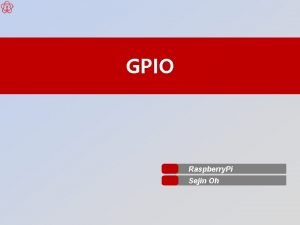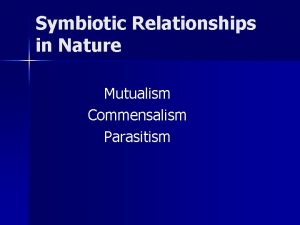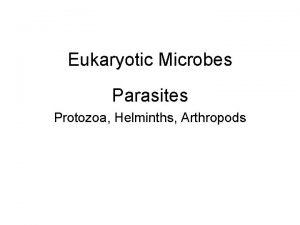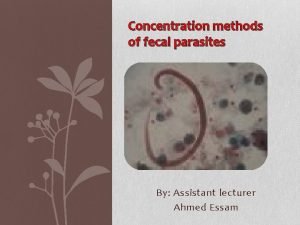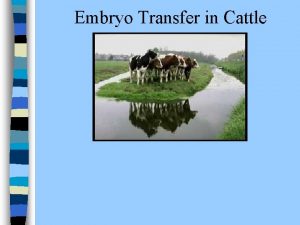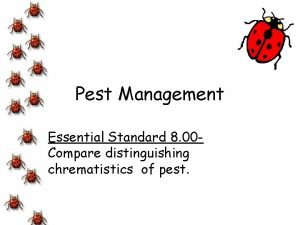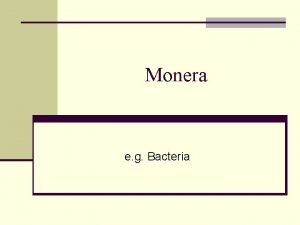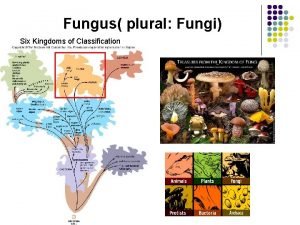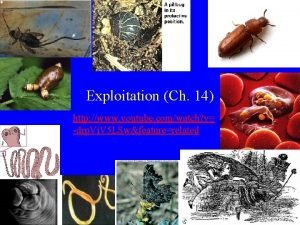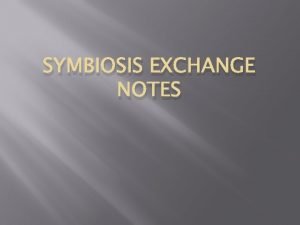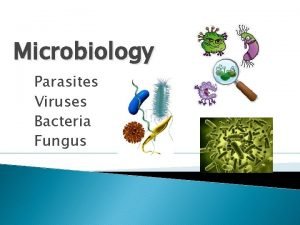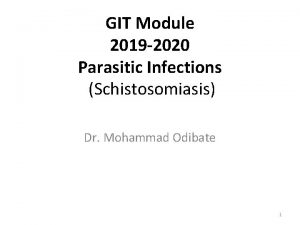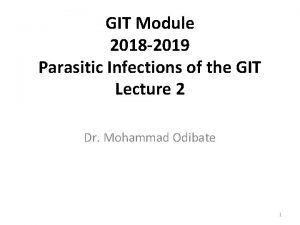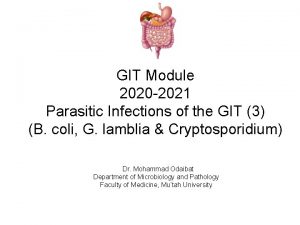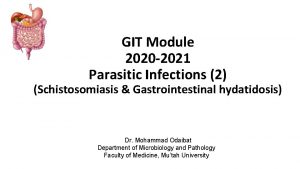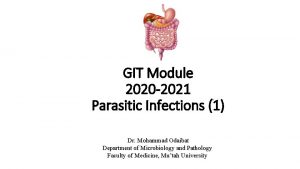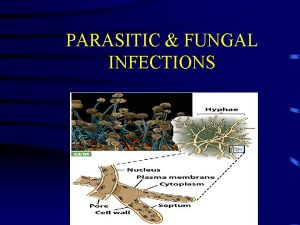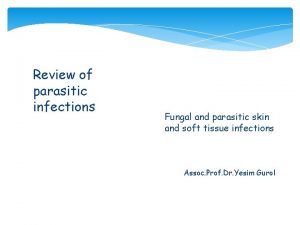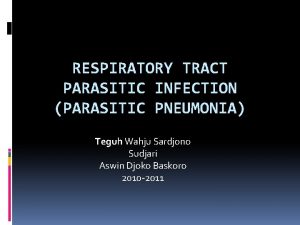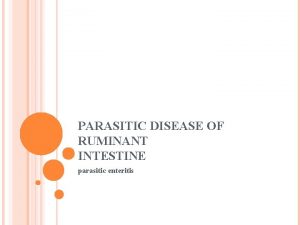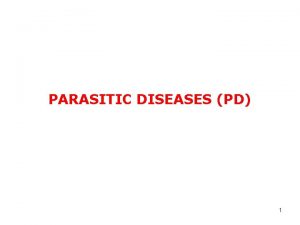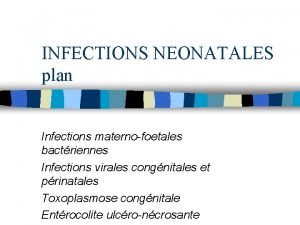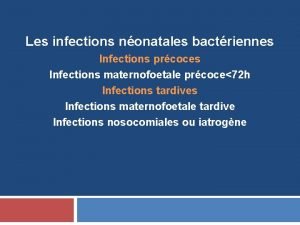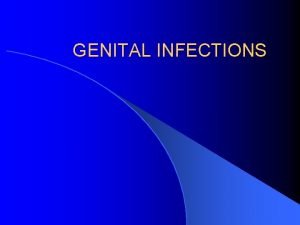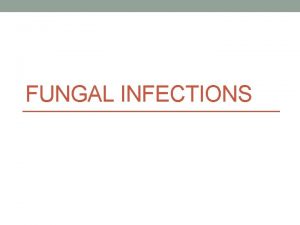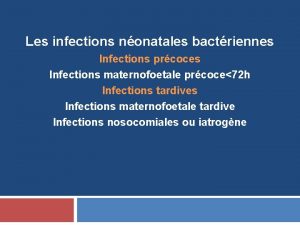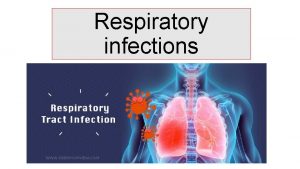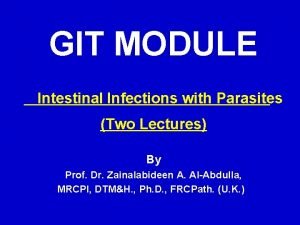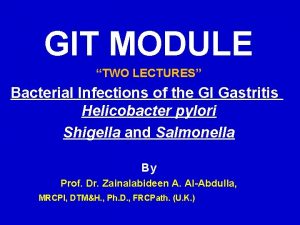GIT Module 2019 2020 Parasitic Infections of the























- Slides: 23

GIT Module 2019 -2020 Parasitic Infections of the GIT Lecture 2 Dr. Mohammad Odibate 1

Nematodes of medical importance Intestinal With tissue stage: • Ascaris lumbricoides • Ancylostoma duodenale • Necator americanus • Strongyloides stercoralis • Trichinella spiralis • Capillaria phillipinensis q Without tissue stage: • Enterobius vermiculars • Trichuris trichiura q Tissue & Blood Small intestine Large int. • Wuchereria bancrofti • Brugia malayi • Loa loa • Onchocerca volvulus • Dracunculus medinensis • Trichinella spiralis q Larva migrans: • Ancylostoma spp. • Toxocara spp. 2

Hookworms Human hookworms Old world hookworms Ancylostoma duodenale New world hookworms Necator americanus

Hookworms Pathogenicity & Clinical Features • Ancylostomiasis or hookworm disease, characterised by iron deficiency anaemia • Majority of infections are asymptomatic • Symptoms develop in heavy infections and divided into three groups: those produced by Migrating larvae Skin invasion Intestinal phase 4

Hookworms- Life Cycle 1 2 3 5

Hookworms- Pathogenesis and symptomatology Skin invasion (ground itch) It is a cutaneous The most common Clinically: lesion produced as a sites usually dermatitis with irritation result of penetration between the toes, and itching followed by of human skin by dorsal surface of erythema, oedema and filariform larva of A. the foot and inter papular rash vesicles duodenale. digital or pustules due to 2 ry hands. are spaces of Local bacterial infection. 6 Papular rash: skin eruption or reaction consisting of small, round, raised bumps that have clear borders.

Hookworms- Pathogenesis and symptomatology Skin invasion (ground itch) ? ? ? ?

Hookworms- Pathogenesis and symptomatology Larval migratory phase To the lung (loeffler's syndrome) To general circulation In heavy infection only, migrating fever, hookworm larvae may pass to cough, dyspnea, haemoptysis the left side of the heart and high eosinophilia. general circulation distributed Symptoms include to different tissues of the body eosinophilic lesions around granulomatous the (visceral larva migrans). larvae 8

Hookworms- Pathogenesis and symptomatology Intestinal phase Injury of the mucous membrane by cutting teeth and plates at the site of attachment ulceration that may be infected nausea, vomiting, pain, flatulence, constipation or diarrhea with black or red stool. Anaemia hypochromic microcytic iron deficiency & aneamia (due to blood loss). Causes: 1 -Each parasite sucks about 0. 5 cc of blood daily. 2 -Bleeding at the site of attachment due to the effect of anticoagulant secreted by the cephalic glands). Hypoproteinaemia, Retardation of nutritional oedema physical, and signs of mental avitaminosis are sexual and due to impairment development in of food absorption heavily infected and blood loss. children. 9

Hookworms- Laboratory diagnosis Stool examination for Examination of stool egg for detection by different methods: • Concentration methods • Faecal cultures. counting technique determination for of by Baermann's technique • Direct smear. • Stoll's larvae the intensity of infection. Blood examination for anaemia

Hookworms- Laboratory diagnosis Laboratory Diagnosis • Stool examination – microscopy: non bile stained egg, segmented • Occult blood in stool – positive • Blood examination – anaemia, eosinophilia 11

Hookworms- Treatment Supportive treatment: -High protein diet. -Vitamins & iron. Mebendazole (Drug of choice) In anaemia, severe blood transfusion may be needed 12

Trichinella Spiralis Pathology (Trichinosis): Major pathology and symptoms: • Stage of intestinal invasion: (5 -7 days)– small intestine edema and inflammation, nausea, vomiting, abdominal pain, diarrhea, headache, and fever. • Stage of larval migration: - fever, urticarial rash, splinter hemorrhages, periorbital & facial edema. • Stage of encystation: asymptomatic in light infections; myalgia, weakness in heavy infections Complications – during migration: – myocarditis, encephalitis 13

Tissue Nematodes Trichinella Spiralis Prevention and Control: • Avoid eating of raw or undercooked pork. • Inspecting meat for infective larvae. • Not feeding raw garbage to pigs. Laboratory Diagnosis: • • • Muscle biopsy – encysted larva Blood – eosinophilia between 2 nd & 4 th week Serology – to detect specific Abs by: 1. Bentonite flocculation test. 2. Latex agglutination test. 14

Prevention and Control: – Proper disposal of human excreta – Personal hygiene. – Avoid the use of human excrement as a fertilizer. – Treatment of infected individuals and health education. – Prevention of consumption of uncooked vegetables & fruits. Wearing protective footwear – Wearing protective footwear 15

Nematodes Ascaris Strongyloides Hookworms Trichuris Enterobius Trichinella spiralis 16

Case Studies • Case 1 A 3 -year-old girl was seen in a small rural clinic with complaints of abdominal pain and upset stomach. A local laboratory performed a routine stool examination and observed the objects shown in the images. The laboratory suspected the objects were artifacts. A portion of the stool concentrate was sent to a reference laboratory for confirmation. What is your diagnosis? 17

Case 2 Case Studies • A 69 -year-old male was undergoing a routine colonoscopy performed as a screen for colorectal cancer. The patient was asymptomatic and a stool ova and parasite examination (O & P) performed prior to the procedure was negative. However, the gastroenterologist recovered a worm from the ascending colon during the procedure and sent it to the pathology laboratory for identification. Figures show what was observed on hematoxylin and eosin (H & E) stained slides. Eggs seen inside the worm measured 50 x 25 micrometers on average. • What is your diagnosis? • Based on what morphologic features. 18

Case Studies • Case 2 19

Case Studies Case 3 • A 45 year old male was referred to the gastroenterology clinic with complaints of epigastric pain, diarrhea and unintentional weight loss over the past couple of weeks. Travel history was significant for a recent mission trip to rural areas of the Philippines. About a month after his return, he developed epigastric pain and clinically significant diarrhea, with 2 -8 bowel movements per day. Testing for blood counts, hepatitis and HIV was performed and stool was collected for culture and O&P. He also underwent a colonoscopy with multiple biopsies. 20

Case Studies Case 4 • A 50 -year-old female from Canada presented to a health care provider with abdominal pain, diarrhea, and peripheral eosinophilia. A stool specimen was collected in sodium acetate-acetic acid-formalin (SAF) and a formalin-ethyl acetate (FEA) concentration was performed. • Figures A-C show what was observed microscopically on a wet mount; Figure C stained with iodine. • What is your diagnosis? Based on what criteria? A B C 21

Case Studies Case 4…. . • This was a case of strongyloidiasis caused by S. stercoralis. B • The morphologic features were consistent with first-stage rhabditiform (L 1) larvae which is the stage usually found in stool. C 22

Case Studies Case 5 A 54 -year-old male was admitted because of having suffered from progressive watery diarrhea for 12 days. He had no history of diabetes mellitus, hypertension, heart disease, organ transplantation, or malignancy. After admission, he still complained of diarrhea despite medical treatment. The laboratory examination showed eosinophilia and a stool examination by the concentration method was negative four times. When a sigmoidoscopy was performed as a part of an explorative survey, a single protruding mass consisting if a moving adult hookworm was found. The fifth stool examination by the concentration method identified hookworm ova. The patient was treated with oral mebendazole 100 mg twice a day for 3 days. The diarrhea and eosinophilia subsided after this treatment. 23
 Git clone git://git.drogon.net/wiringpi
Git clone git://git.drogon.net/wiringpi Commensalism
Commensalism Ascaris lumbricoides
Ascaris lumbricoides Parasitic ova
Parasitic ova Parasitic cone
Parasitic cone Parasitic cone
Parasitic cone Parasitic computing seminar report
Parasitic computing seminar report Is rhizopus saprophytic or parasitic
Is rhizopus saprophytic or parasitic N
N Certain infectious and parasitic diseases
Certain infectious and parasitic diseases Unit 1 diversity in the living world
Unit 1 diversity in the living world Insect name
Insect name Monera bacteria
Monera bacteria Fungi in plural
Fungi in plural Youtube
Youtube What is multualism
What is multualism Parasitic bacteria examples
Parasitic bacteria examples Parasitic fungi
Parasitic fungi Detritus food chain
Detritus food chain Opportunistic infections
Opportunistic infections Methotrexate yeast infection
Methotrexate yeast infection Opportunistic infections
Opportunistic infections A bacterial std that usually affects mucous membranes
A bacterial std that usually affects mucous membranes Understanding the mirai botnet
Understanding the mirai botnet
